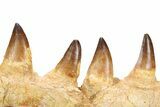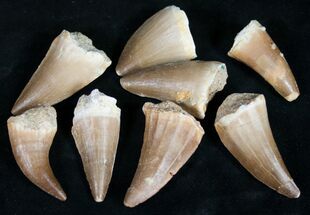This Specimen has been sold.
22" Mosasaur (Prognathodon) Jaw with Ten Teeth - Morocco
Due to the size and fragile nature of this piece it will be shipped in a crate on a pallet via freight. Our website can't automatically calculate freight shipping costs so these costs will be calculated and billed after purchase. Please contact us prior to purchase if you need a shipping quote.
This is an impressive 22" fossil jaw section of a mosasaur (Prognathodon sp.), collected from the Phosphate Deposits near Khouribga, Morocco. It is a mandible (lower jaw) section from the right side of the mosasaur skull. The specimen shows off many of the foramen, contains ten teeth still attached to the jaw, and multiple unerupted teeth that have been partially exposed.
There are crack repairs to many of the teeth with spots of minor restoration. The jaw bone has been stabilized with glue and has a few spots of gap fill restoration within repaired cracks.
Comes with a display stand.
This is an impressive 22" fossil jaw section of a mosasaur (Prognathodon sp.), collected from the Phosphate Deposits near Khouribga, Morocco. It is a mandible (lower jaw) section from the right side of the mosasaur skull. The specimen shows off many of the foramen, contains ten teeth still attached to the jaw, and multiple unerupted teeth that have been partially exposed.
There are crack repairs to many of the teeth with spots of minor restoration. The jaw bone has been stabilized with glue and has a few spots of gap fill restoration within repaired cracks.
Comes with a display stand.
It comes from the massive phosphate deposits in the Oulad Abdoun Basin near Khouribga, Morocco. These deposits are mined for phosphate, one of Morocco's biggest exports. The fossils are collected as a byproduct of the mining operations, saving them from certain destruction by the rock crusher.
Mosasaurs were a family of enormous marine reptiles that truly dominated the seas 90 million years ago, ruling during the last 20-25 million years of the Cretaceous period. With the extinction of the ichthyosaurs and decline of plesiosaurs, mosasaurs diversified to become prolific apex predators in nearly every habitat of the oceanic world.
Larger mosasaurs were the great leviathans of their time, extending 10–15 meters, or 33–49 feet long. Hainosaurus holds the record for the longest mosasaur at a seemingly impossible 57 feet. The smaller genera were still an impressive 10–20 feet long.
Mosasaurs probably evolved from semi-aquatic scaled reptiles, perhaps more similar in appearance to modern-day monitor lizards. They had double-hinged jaws and flexible skulls much like that of a snake which enabled them to gulp down their prey almost whole.
The gruesome unchewed contents of fossilized mosasaur guts have revealed a varied diet of sea birds, ammonites, smaller marine lizards, possibly sharks, and even other mosasaurs. Ammonites were especially crunchy mosasaur treats. They were abundant in the Cretaceous seas, and some mosasaurs had specialized teeth for the job.
Mosasaurs probably lurked for an ambush, rather than hunt, using their powerful tail flukes for extra thrust to dart out and swallow unsuspecting prey. Non-reflective, keeled scales may have been a great advantage to the mosasaur sneak-attack.
Mosasaurs breathed air and gave birth to live young. The bronchi leading to the lungs run parallel to each other, instead of splitting apart from one another as in monitors and other terrestrial reptiles. They were well-adapted to living in the warm, shallow, epicontinental seas of the period.
Although mosasaurs diversified and proliferated at a spectacular rate, their specialization is considered the source of their demise when marine systems collapsed at the end of the Cretaceous.
Larger mosasaurs were the great leviathans of their time, extending 10–15 meters, or 33–49 feet long. Hainosaurus holds the record for the longest mosasaur at a seemingly impossible 57 feet. The smaller genera were still an impressive 10–20 feet long.
Mosasaurs probably evolved from semi-aquatic scaled reptiles, perhaps more similar in appearance to modern-day monitor lizards. They had double-hinged jaws and flexible skulls much like that of a snake which enabled them to gulp down their prey almost whole.
The gruesome unchewed contents of fossilized mosasaur guts have revealed a varied diet of sea birds, ammonites, smaller marine lizards, possibly sharks, and even other mosasaurs. Ammonites were especially crunchy mosasaur treats. They were abundant in the Cretaceous seas, and some mosasaurs had specialized teeth for the job.
Mosasaurs probably lurked for an ambush, rather than hunt, using their powerful tail flukes for extra thrust to dart out and swallow unsuspecting prey. Non-reflective, keeled scales may have been a great advantage to the mosasaur sneak-attack.
Mosasaurs breathed air and gave birth to live young. The bronchi leading to the lungs run parallel to each other, instead of splitting apart from one another as in monitors and other terrestrial reptiles. They were well-adapted to living in the warm, shallow, epicontinental seas of the period.
Although mosasaurs diversified and proliferated at a spectacular rate, their specialization is considered the source of their demise when marine systems collapsed at the end of the Cretaceous.
SPECIES
Prognathodon sp.
LOCATION
Oulad Abdoun Basin, Morocco
FORMATION
Phosphate Deposits
SIZE
22" long
CATEGORY
SUB CATEGORY
ITEM
#259678
We guarantee the authenticity of all of our specimens.
 Reviews
Reviews



















